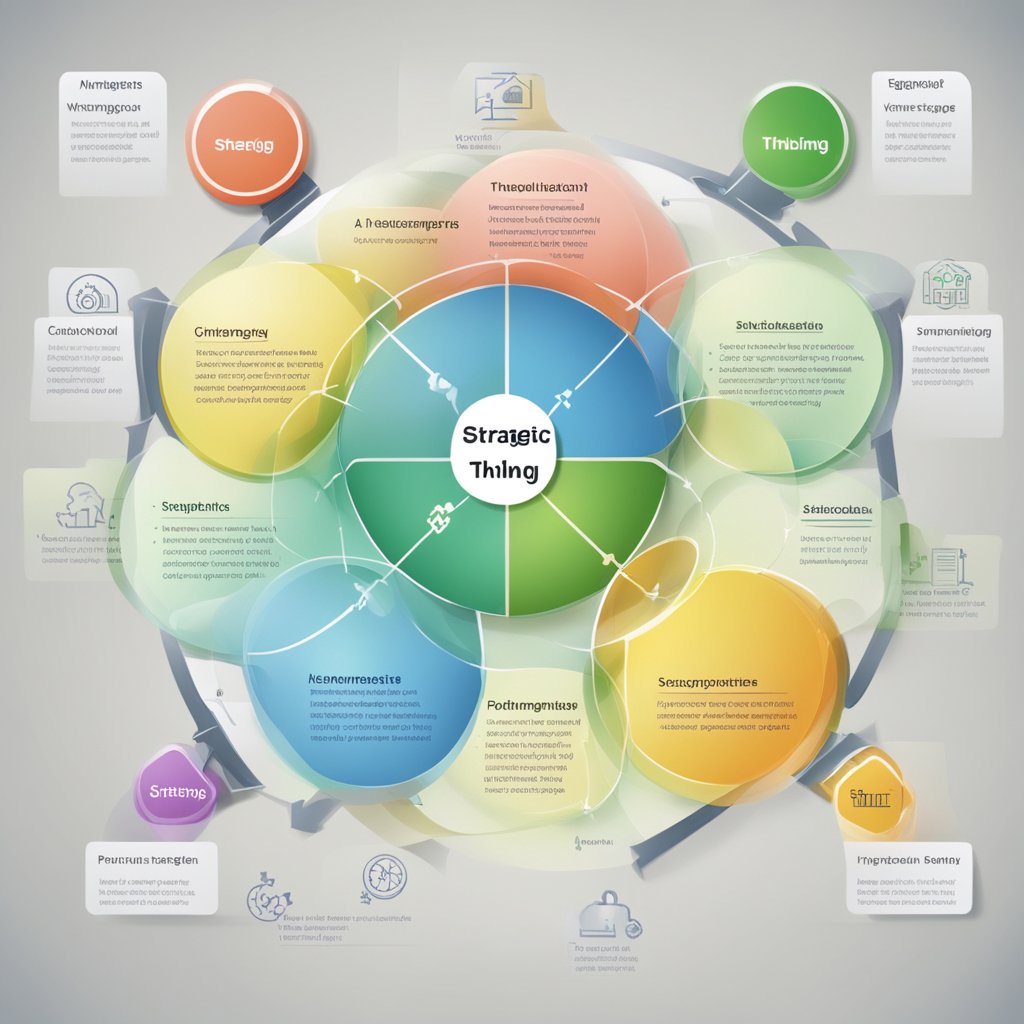Strategic thinking is a crucial skill that allows individuals and organizations to plan for the future, connecting different pieces of information, weighing options, and formulating plans that align with overarching goals. It is a blend of analytical thinking, creativity, and foresight that enables individuals and organizations to navigate uncertainty and complexity effectively. Examples of strategic thinking abound across various industries and disciplines, showcasing the importance of this skill in driving innovation, tackling challenges, and seizing opportunities for growth.


When applied to an organizational context, strategic thinking has been found to play a vital role in enhancing overall performance and establishing a competitive edge. This skill set enables leaders to make informed decisions and allocate resources in a manner that positions their organization for long-term success. Moreover, fostering a culture of strategic thinking within an organization can empower employees at all levels, enabling them to contribute to the organization’s long-term success.
Key Takeaways
- Strategic thinking is a vital skill that combines analytical thinking, creativity, and foresight, essential for long-term planning and decision-making.
- In an organizational context, strategic thinking enhances performance, fosters innovation, and leads to a competitive advantage.
- Cultivating strategic thinking among employees can empower them to contribute to the organization’s long-term success and drive growth.
Foundational Concepts of Strategic Thinking


Strategic thinking involves the ability to analyze situations, identify patterns, and anticipate potential outcomes with a long-term perspective. It goes beyond problem-solving tasks and embraces a broader vision, considering the immediate and future implications of actions and decisions. When compared to critical thinking, strategic thinking has the added focus on a broader vision that incorporates the organization’s mission and vision.
One of the key aspects of strategic thinking is developing a strategic mindset. This mindset enables individuals and organizations to balance short-term priorities with long-term objectives. It involves an understanding of the organization’s goal, the external and internal factors that may affect its achievement, and the resources needed to attain it.
Having a clear vision and mission is essential for strategic thinking. A vision refers to the ideal future state an organization wants to achieve, while a mission defines the purpose and reason for its existence. Both these elements provide direction and focus in formulating long-term plans and decisions.
Strategic thinking includes some key skills and practices. For instance:
- SWOT analysis: This is an evaluation tool that helps organizations assess their strengths, weaknesses, opportunities, and threats. By understanding the internal and external factors, strategic thinkers can make informed decisions that align with their vision and mission.
- Scenario planning: It involves considering possible future events or situations and preparing for them. This proactive approach allows organizations to anticipate challenges and develop strategies to mitigate potential risks.
- Prioritization: Strategic thinkers must be skilled in prioritizing tasks according to their urgencies and importance. This enables them to focus on critical tasks while delegating or postponing less critical ones.
- Flexibility: In an ever-changing environment, strategic thinkers must be adaptable and open to revising their plans as needed. Being able to pivot and adjust strategies quickly ensures that their organization remains on track towards its goals even when circumstances change.
To sum up, strategic thinking is a crucial competency that helps organizations achieve their desired outcomes. It involves elements like having a strategic mindset, defining a clear vision and mission, and employing a set of skills and practices that facilitate long-term planning and decision-making. Developing strategic thinking skills is essential for individuals aiming to be successful leaders and contributors to their organization’s growth and success.
The Role of Strategic Thinking in Organizational Success


Strategic thinking plays a crucial role in the success of an organization. It involves envisioning future goals and objectives, as well as devising effective methods to achieve them. This process requires leaders to consider both internal and external factors, such as market trends, competition, and organizational strengths and weaknesses.
Leaders who excel in strategic thinking are able to identify opportunities and threats early on, which allows their organization to respond proactively and maintain a competitive edge. By adopting a long-term perspective, these leaders can make better-informed decisions that take advantage of emerging trends and technologies. They can also align the organization’s resources and actions toward achieving its objectives.
Additionally, strategic thinking fosters a culture of innovation and continuous improvement. Leaders who encourage their teams to think critically and creatively about organizational challenges are better equipped to identify and implement novel solutions. This type of leadership enables organizations to adapt, grow, and thrive in a dynamic business environment.
Senior executives have a particularly important role in promoting strategic thinking throughout the organization. By setting a vision and clearly communicating it to employees at all levels, they can foster a sense of purpose and direction. Furthermore, senior leaders who demonstrate strategic thinking skills can serve as role models, inspiring their teams to think and act more strategically.
In conclusion, strategic thinking is a vital skill for organizational success. By prioritizing long-term vision, leaders can create a roadmap for achieving objectives, seizing opportunities, and maintaining a competitive advantage. Cultivating a strategic mindset across all levels of an organization ultimately leads to better decision-making, innovation, and alignment of resources toward achieving shared goals.
Embedding Strategic Thinking in Planning Process


Incorporating strategic thinking in the planning process is essential for achieving desired outcomes and optimizing resources. This involves analyzing the current situation, setting goals, and devising action plans that align with the organization’s overall objectives.
The first step in the process is to gather information about the problem or situation to develop a deep understanding of the challenges at hand. A thorough analysis of the available data combined with market research will enable the organization to identify its strengths, weaknesses, opportunities, and threats (SWOT analysis).
Once the SWOT analysis is complete, the organization can then set strategic goals and objectives, considering both short-term and long-term perspectives. This requires the ability to connect the dots between various pieces of information, weigh options, and anticipate future developments.
The next step is to create action plans that outline the specific steps, tasks, and responsibilities necessary to achieve each objective. This involves allocating appropriate resources, setting timeframes, and identifying performance measures to monitor and evaluate progress. Encouraging open communication and feedback among team members will enable the organization to continuously enhance its strategic planning process and ensure alignment with the broader goals.
Throughout this planning process, the organization must ensure a strong focus on its resources to maximize their potential and avoid waste. This can be achieved by focusing resources wisely on tasks and initiatives that directly contribute to the strategic objectives, regularly assessing resource allocation, and adjusting plans when necessary.
By embedding strategic thinking in the planning process, organizations can create comprehensive, adaptable plans that drive decision-making, provide a clear direction, and ultimately, enable the achievement of its desired outcomes.
Leveraging Strategic Thinking for Identifying Opportunities
In the world of business and entrepreneurship, strategic thinking is crucial for identifying and capitalizing on new opportunities. It allows individuals and organizations to navigate the ever-changing landscape and uncover innovative solutions to pressing challenges. By adopting a strategic mindset, entrepreneurs can overcome obstacles and make informed decisions, ensuring they stay ahead of the competition.
One key aspect of strategic thinking is the ability to gather information and analyze the market. This process equips entrepreneurs with a comprehensive understanding of industry trends, competitors, and potential customers. As a result, they can spot opportunities that others may overlook, giving them a competitive edge. For example, Apple’s focus on product design, innovation, and customer experience has enabled the company to dominate the technology market and be recognized as a leader in their field (source).
Another important facet of strategic thinking is the ability to prioritize tasks and allocate resources efficiently. This may involve focusing on projects that yield the highest return on investment or those that align with the organization’s long-term goals. A successful entrepreneur must possess the ability to focus resources wisely and avoid spreading themselves too thin across multiple ventures. This will ensure that the organization operates effectively and adapts to the ever-changing demands of the market.
Additionally, strategic thinking helps entrepreneurs anticipate and navigate potential challenges they may encounter. By assessing risks and developing contingency plans, they can tackle obstacles head-on without allowing them to obstruct progress. For instance, considering an organization’s financial constraints and identifying potential partnerships or alternative funding options can help circumnavigate budgetary challenges.
In conclusion, leveraging strategic thinking is instrumental in identifying opportunities and mitigating challenges in the entrepreneurial landscape. By adopting a strategic mindset, entrepreneurs can innovate, allocate resources efficiently, and navigate potential obstacles, ultimately driving success in their endeavors. The future of any organization lies in the hands of its leaders and their ability to think strategically.
Strategic Thinking in Problem-Solving and Decision Making
Strategic thinking plays a vital role in both problem-solving and decision making. By applying strategic thinking, individuals and organizations are able to assess complex situations, identify possible solutions and make informed decisions that lead to desirable outcomes.
In problem-solving, strategic thinking helps to break down the issue at hand into smaller, manageable components. This approach allows for a deeper understanding of the root cause, and with this knowledge, it becomes easier to develop effective solutions. One common method to exercise strategic thinking in problem-solving is task prioritization. By ranking tasks according to their urgency and importance, individuals can focus their efforts on addressing the most critical aspects of the problem first.
In decision making, strategic thinking enables individuals to weigh the benefits and drawbacks of various options, considering both short-term and long-term consequences. This process involves gathering information, analyzing data, and evaluating different courses of action before making a final decision. In organizations, strategic thinking is often used in areas such as resource allocation, product development, and customer experience. A notable example is Apple, a technology giant known for its innovative products and focus on customer experience, which has achieved success through strategic planning and decision making.
Developing problem-solving and decision-making skills through strategic thinking requires constant practice, reflection, and learning. By honing these skills in oneself or within a team, individuals and organizations can navigate complex situations with confidence and clarity, leading to more effective and efficient outcomes.
Implementing Strategic Thinking in Technology
Strategic thinking in technology involves identifying opportunities for growth and innovation while taking into account a company’s strengths, weaknesses, and competition. One of the key aspects of strategic thinking includes finding ways to integrate innovative solutions into the organization’s operations.
In the technology industry, there is a constant need for organizations to stay ahead of the curve and create new products and services. One example of strategic thinking applied successfully is Apple. The company has continuously focused on product design, innovation, and customer experience to stay ahead of its competitors. By frequently assessing the market trends and customer needs, Apple has been able to develop groundbreaking products such as the iPhone, iPad, and MacBook.
Another example in the technology sector is the implementation of cloud computing. As organizations continue to generate massive amounts of data, there is an increasing need for secure and scalable platforms to store and manage this information. Companies like Amazon Web Services, Microsoft Azure, and Google Cloud are competing to provide the most efficient and innovative solutions for businesses to manage their data. Strategic thinking in this context entails understanding the evolving market demands and developing infrastructures that cater to a wide range of industries and applications.
In order to sustain success with strategic thinking in technology, leaders need to invest in upskilling their workforce and fostering a culture of learning and innovation. Emphasizing the importance of continuous improvement, staying updated with the latest trends, and adapting to new technologies will ensure long-term success for organizations.
Implementing strategic thinking in technology is crucial for businesses to stay ahead in a competitive market. By identifying opportunities, integrating innovative solutions, and constantly upskilling the workforce, companies can position themselves as leaders in the industry.
Resource Allocation and Efficiency through Strategic Thinking
Strategic thinking plays a crucial role in optimizing resource allocation, productivity, and efficiency in various aspects of an organization. By incorporating a well-thought-out strategy, businesses can allocate resources such as time, effort, and tangible assets in a way that maximizes project efficiency and output ^(1).
One primary application of strategic thinking in resource allocation is the concept of strategic alignment. This process ensures that all components of an organization, including departments, teams, and resources, are properly organized and working harmoniously to achieve the defined strategy or objectives ^(2). This alignment can lead to improved productivity and efficiency by reducing conflicts and redundancies in managing resources.
In the context of multi-business firms, strategic management involves corporate capital allocation to divisions, which helps in the efficient distribution of resources ^(3). Such an approach aids the company in leveraging its strengths and identifying growth opportunities within its various divisions.
When considering strategic thinking in terms of resource allocation, Andrew Marshall’s notion of strategy is worthy of consideration. He suggests viewing strategy as a “process of identifying, creating, and exploiting asymmetric advantages that can be used to achieve or improve sustainable competitive advantages” ^(4). By applying this perspective, organizations can identify areas where they hold a competitive edge and allocate resources accordingly to optimize efficiency.
In conclusion, strategic thinking is an essential tool for enhancing resource allocation, productivity, and efficiency within organizations. By aligning resources with company objectives, identifying growth opportunities, and exploiting competitive advantages, businesses can achieve a higher level of performance and long-term success.
The Impact of Strategic Thinking on Employees and Leaders
Strategic thinking is a crucial skill that can significantly enhance the performance and career progression of both employees and leaders. It empowers individuals to take a holistic view of their organization, enabling them to identify new opportunities, solve complex problems, and drive innovation.
Employees who can think strategically are a valuable asset to an organization, as they contribute to its bottom line, advancing its competitive position in the market. These individuals display initiative, creativity, and problem-solving skills which ultimately helps in their career growth. Employers recognize the ability of these employees to think critically and proactively, making them prime candidates for promotions and greater responsibility.
Leaders who possess strong strategic thinking capabilities can inspire and guide their team towards the realization of the company’s vision. By cultivating a culture of strategic thinking within their team, leaders can harness the collective creativity and problem-solving abilities of their team members. This leads to a more innovative and adaptive organization that can respond quickly to changes in the market, customer demands, and competitive pressures.
Furthermore, strategic thinking helps employees and leaders adopt a growth mindset. They are more likely to embrace change, continuously learn, and collaborate effectively with their colleagues. This mindset contributes to a healthier work environment, fostering a positive atmosphere of openness, which leads to the exchange of innovative ideas and improved decision-making processes.
In summary, strategic thinking has a profound impact on both employees and leaders, as it enables them to identify opportunities for growth, tackle challenges effectively, and contribute significantly to the overall success of their organization. Moreover, it fosters a positive work environment that nurtures creative collaboration, resulting in continuous innovation and growth.
Strategic Thinking for Students
Strategic thinking plays an essential role in a student’s academic journey, as it allows them to effectively prioritize tasks, navigate challenges, and optimize their learning experience. By applying strategic thinking principles, students can enhance their problem-solving skills and better understand the long-term implications of their actions and decisions.
One example of strategic thinking for students involves task prioritization. By consciously ordering or ranking tasks according to their urgency and importance, students can manage their time more effectively and ensure they’re focusing on what truly matters. This Eisenhower’s Urgent/Important Principle is an excellent method students can employ to balance their academic and personal responsibilities.
Students can also benefit from strategic thinking when it comes to managing dissent. When encountering disagreements or conflicting opinions, applying strategic thinking allows them to objectively analyze the situation, identify patterns, and anticipate potential outcomes. By viewing dissent as an opportunity for growth, students can learn to engage in constructive debates, which ultimately strengthens their critical thinking and communication skills.
Moreover, strategic thinking contributes to effective learning. By gathering information from various sources, students develop a deeper understanding of the topics and subjects at hand. Information-gathering techniques can include attending lectures and seminars, taking notes efficiently, asking thought-provoking questions, and engaging in discussions with professors and classmates. Students can further enhance their learning strategies by applying critical analysis to the information obtained, seeking out patterns or trends, and synthesizing seemingly unrelated concepts into a coherent whole.
In conclusion, strategic thinking serves as a valuable skill for students, enhancing their decision-making, time management, and overall academic performance. By incorporating strategic thinking principles in their daily routines, students can expect to see a significant improvement in their learning outcomes and prepare themselves for long-term success in their chosen fields.
Strategic Thinking in Dealing with External Factors
When engaging in strategic thinking, it is important to consider the outside world, as it can affect the overall success of a business. By analyzing external factors, such as competitors, threats, and risks, businesses can better understand their environment and develop strategies to navigate through challenges and capitalize on opportunities.
A key aspect of strategic thinking involves connecting the dots between different pieces of information and using this insight to make informed decisions. By gathering data on competitors and staying updated on market trends, businesses can adapt their strategies to maintain a competitive edge.
Identifying Threats and Risks
Understanding potential threats and risks to a business is essential in creating a robust strategic plan. This includes recognizing how changes in regulations, technological advancements, or shifts in consumer behavior might impact the company. For example, an increase in tariffs or introduction of new environmental regulations might affect a strategic plan. By identifying these potential risks, businesses can proactively address them and develop contingency plans for future scenarios.
Embracing Opportunities
Strategic thinking also involves identifying opportunities in the external landscape that can add value to a business. By assessing market trends, emerging technologies, or untapped demographics, companies can seize new opportunities for growth and expansion. Actively monitoring the external environment and being open to innovation is crucial for staying ahead in a constantly evolving business landscape.
Collaborating and Learning from Others
Learning from competitors and other industry players can also provide valuable insights that can be applied to a company’s strategic thinking process. By studying their successes and failures, businesses can identify best practices, recognize emerging trends, and avoid pitfalls. In addition, collaboration and building relationships with stakeholders in the external environment can help businesses leverage existing resources and gain valuable support in achieving their strategic objectives.
In conclusion, strategic thinking must not be limited to internal factors; it is crucial for businesses to consider the outside world, embrace opportunities, and proactively manage threats to ensure success in a rapidly changing global environment. Companies that implement these practices are better equipped to navigate uncertainty and maintain competitive in the market.
The Role of Strategic Thinking in Adapting and Innovating
Strategic thinking plays a crucial role in enabling individuals and organizations to adapt and innovate in the face of dynamic environments. By employing foresight and anticipating potential outcomes, it equips decision-makers with the ability to respond effectively to changing circumstances.
One aspect of strategic thinking that contributes to adaptability is the use of scenarios. Scenario planning involves envisioning possible futures, taking into account various factors and trends that may impact an organization. This approach not only highlights potential risks and opportunities, but it also encourages proactive measures when faced with uncertainty.
Another significant element of strategic thinking is the development of foresight. Foresight, or the ability to think long-term, allows an organization to identify patterns and trends that could drive growth or create challenges. By considering the future implications of decisions made today, leaders can make more informed choices that align with their organization’s objectives and market conditions.
Ultimately, strategic thinking fosters an organizational culture that values adaptability as a core competency. This mindset allows teams and individuals to embrace change and continuously improve their operations, processes, and products, strengthening their competitive advantage in the market. A strong focus on adaptability also positions the organization to capitalize on emerging opportunities and navigate potential challenges effectively.
In conclusion, the role of strategic thinking in adapting and innovating is evident in its ability to foster foresight, encourage scenario planning, and promote adaptability. By cultivating these skills and practices, organizations can better navigate an ever-changing landscape and remain agile in the face of adversity.
Strategic Thinking Case Study: Harvard Business School
Harvard Business School (HBS) has long been recognized as a leader in cultivating strategic thinkers. Their faculty and curriculum focus on equipping students with the skills necessary to navigate complex business landscapes and make informed decisions that drive value within organizations. One effective method HBS employs to achieve this, is through the use of case studies.
Case studies at HBS provide students with real-world examples of business dilemmas and require them to evaluate various aspects, such as competition and market dynamics, financial information, and stakeholder interests. By engaging in such practical exercises, students are able to develop their strategic thinking capabilities. For example, the famous Lincoln Electric Company case study examinмes the unique compensation system and organizational culture that have contributed to the firm’s success.
Another notable case study is Pal’s Sudden Service, which highlights how an efficient organizational model can lead to rapid growth. Students at HBS are encouraged to dissect such examples in order to gain insights into the tenets of strategic thinking, such as acumen, foresight, and competitive advantage.
Furthermore, HBS also offers a course on Strategy and Strategic Thinking to help students further understand the concept and develop their skills. This course delves into various frameworks that can assist managers in evaluating a strategy’s effectiveness and making strategic decisions within their respective organizations. Through lectures, discussions, and hands-on exercises, students are able to hone their strategic thinking abilities in a supportive and immersive learning environment.
In sum, by utilizing case studies and offering dedicated courses on strategic thinking, Harvard Business School equips its students with the essential skills and knowledge required to become confident, knowledgeable, and pertinent strategic thinkers in the business world.
Action Plans and Priorities through Strategic Thinking
In the realm of business and personal success, strategic thinking plays a crucial role in effectively tackling challenges and achieving goals. By creating action plans and setting priorities through strategic thinking, individuals and organizations can efficiently allocate resources, streamline operations, and optimize outcomes.
A critical aspect of strategic thinking is gathering information and knowledge about the problem or situation at hand. This helps to develop a deeper understanding of the challenges faced, enabling the formulation of suitable action plans. An effective action plan should consider potential risks, constraints, and the necessary steps to address them.
Once an action plan is in place, prioritizing tasks according to their urgency and importance becomes essential. This process aligns with the logic of Eisenhower’s Urgent/Important Principle, which helps individuals and organizations to differentiate time-sensitive tasks from those that could be delegated or delayed. By focusing on high-impact tasks first, individuals and teams can work towards their objectives more effectively.
Moreover, strategic thinking involves analyzing various inputs such as financial statements, market conditions, and internal resource allocation. This analysis allows leaders to make informed decisions that position the organization for success in the long term. Additionally, it enables them to identify opportunities for growth, collaboration, and innovation.
Ultimately, implementing action plans and setting priorities through strategic thinking contributes to improved decision-making and better results. By adopting a strategic mindset, individuals and organizations can optimize resource allocation, maintain focus on critical tasks, and actively progress towards achieving their goals.





